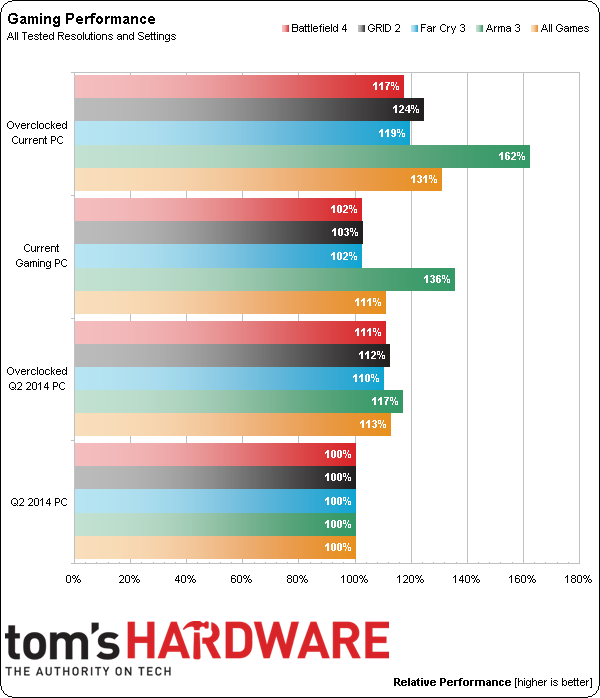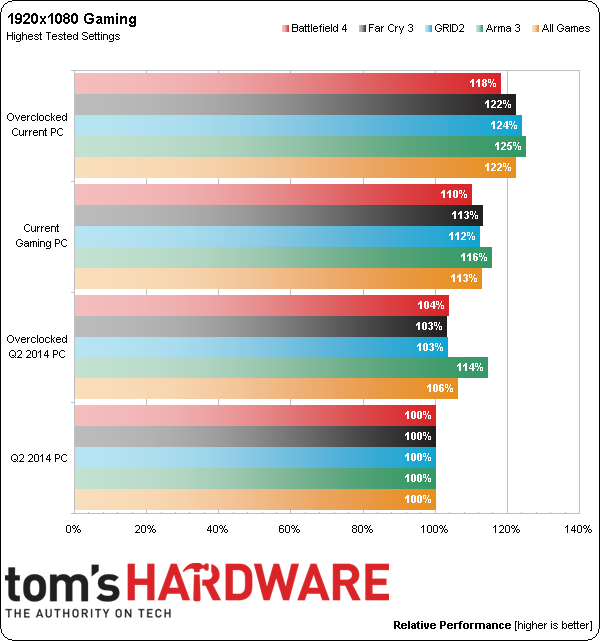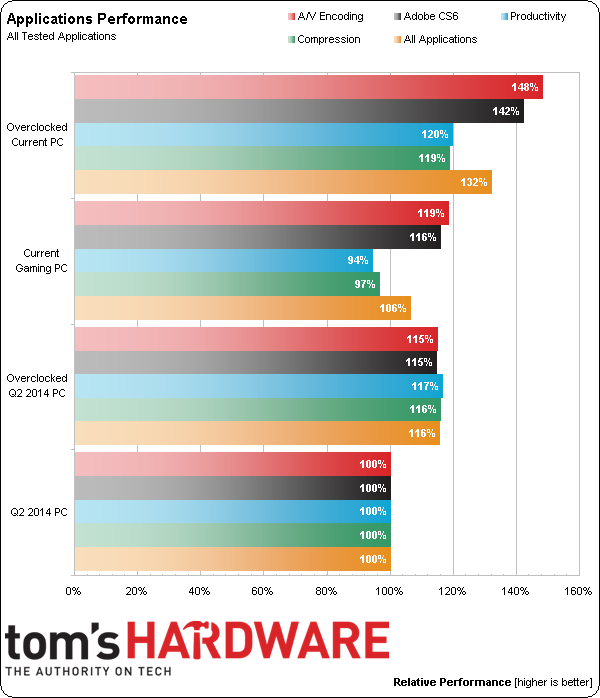System Builder Marathon Q3 2014: Budget Gaming PC
Performance Summary
As we draw comparisons between my most recent entry-level System Builder Marathon gaming PCs, we'll use the older machine as the baseline.
Tallying average frame rates throughout all resolutions emphasizes CPU performance. Yet, our new machine, armed with only a lowly 3.2 GHz dual-core Pentium, actually kicks performance up a notch in all four of our test games.
And it simply dominates once we overclock.
Cranking up the eye candy at 1920x1080 obviously shifts demands over towards the graphics hardware. Here, stepping up from a Radeon R7 265 to the R9 270 rewards us with better performance and/or higher playable settings, again, in all four games.
Our new PC is clearly better suited for 4800x900 gaming. Before we even considered overclocking, it had already surpassed last quarter’s tweaked machine in all four games. However, if you intend to game across three panels, consider budgeting for an even more potent graphics solution.
Although these machines were both built to play games, most value-oriented boxes need to be capable elsewhere, too. Our System Builder Marathons generally base value on overall system performance, so it’s reassuring to see that this quarter's config is a step up in other disciplines as well. In fact, overclocked to 4.1 GHz, it trades blows with and eventually bests our Q1 $750 PC, which included a pricier Core i3-4130 fixed at 3.4 GHz. Let's not fool ourselves though; this dual-core processor is still bound to appear slow compared to whatever Don and Thomas put together over the next two days.
Get Tom's Hardware's best news and in-depth reviews, straight to your inbox.
Current page: Performance Summary
Prev Page Power Consumption And Temperatures Next Page Did We Build a Better Machine?-
g-unit1111 I would personally love to get a Pentium G3258 for my HTPC, it's only like $50 at Micro Center and the motherboard is $70 at Newegg. Hmm... decisions, decisions. :lol:Reply -
ScienceGuy3 What about the Frame Times? Isn't this processor notorious for bad frame times in heavily threaded games like BF4?Reply -
elbert Replyserves up to 30 A across its +12 V rails.
Its rated to serve up to 30 Amps but can do far more. Tests on this little gem shows it can output 22amps on each rail and maxes out around 38~39 Amps on both. Im paraphrasing a popular power supply testing site. Max wattage is about 553ish which is a good deal more than rated. This power supply can't be certified due to it lacks a circuit required but exceeds 80 percent efficiency. -
de5_Roy a lot of things went right for this build: amd introduced the full pitcairn/curacao gpu based r9 270 under 150w, needing single 6 pin pcie power connector, cryptocurrency craze was over and gfx card prices came down, hdd prices came down to sane levels, cpu-overhead-reducing gfx card drivers came out, intel released an unlocked dual core cpu and allowed o.c. bioses....Reply -
jdwii I'm just not sure for one they didn't show latency times. I'm pretty sure this build will suck for future gaming to such as GTA5.Reply
http://www.tomshardware.com/reviews/pentium-g3258-overclocking-performance,3849-5.html
When toms reviewed this CPU it was shown to have poor latency
For a 500$ build i would probably do a 6300+265 build. 600$ i would probably jump the build up to a I5+265 or 8320+270X. -
Onus No stuttering? Very interesting; looks like more testing might be needed, but perhaps settings can also be adjusted.Reply -
akula2 Since this CPU is super performer on various fronts (single core), so why not this config?Reply
Pentium G3258 - $69.97
NZXT Kraken X31 - $73.98
Asus MAXIMUS VII HERO - $203.99
G.Skill Trident X Series 16GB (2 x 8GB) DDR3-2133 - $184.99
Crucial M550 1TB 2.5" SSD - $447.98
Asus GeForce GTX 970 4GB STRIX - $349.99
NZXT Phantom 530 (White) - $121.98
EVGA 650W ATX12V - $64.99 (not sure about its power good signal value?)
Asus DRW-24B1ST/BLK/B/AS DVD/CD Writer - $16.99
Asus VG248QE Monitor - $264.99
D-Link DWA-171 802.11a/b/g/n/ac USB 2.0 - $29.27
Logitech MK550 w/Laser Mouse - $49.99
Corsair Vengeance 2100 - $79.99
Logitech Z506 155W 5.1ch - $69.99
Microsoft Windows 8.1 Professional (32/64-bit) - $170.99
Total: $2200
What you guys think? Usage? Racing Games at homes, audio/video encoding etc. I don't need K CPUs because I'm not in a hurry in this case.
Power source: 100% green aka Solar energy. -
alchemy69 Very similar to the system I just put together for myself except that I felt a 260X was more than enough power for the GPU and put the savings towards a small SSD for the boot drive.Reply




